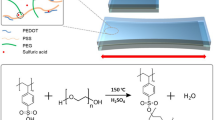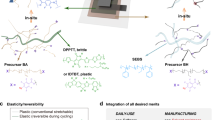Abstract
Stretchable polymer semiconductors (PSCs) are essential for soft stretchable electronics. However, their environmental stability remains a longstanding concern. Here we report a surface-tethered stretchable molecular protecting layer to realize stretchable polymer electronics that are stable in direct contact with physiological fluids, containing water, ions and biofluids. This is achieved through the covalent functionalization of fluoroalkyl chains onto a stretchable PSC film surface to form densely packed nanostructures. The nanostructured fluorinated molecular protection layer (FMPL) improves the PSC operational stability over an extended period of 82 days and maintains its protection under mechanical deformation. We attribute the ability of FMPL to block water absorption and diffusion to its hydrophobicity and high fluorination surface density. The protection effect of the FMPL (~6 nm thickness) outperforms various micrometre-thick stretchable polymer encapsulants, leading to a stable PSC charge carrier mobility of ~1 cm2 V−1 s−1 in harsh environments such as in 85–90%-humidity air for 56 days or in water or artificial sweat for 42 days (as a benchmark, the unprotected PSC mobility degraded to 10−6 cm2 V−1 s−1 in the same period). The FMPL also improved the PSC stability against photo-oxidative degradation in air. Overall, we believe that our surface tethering of the nanostructured FMPL is a promising approach to achieve highly environmentally stable and stretchable polymer electronics.
This is a preview of subscription content, access via your institution
Access options
Access Nature and 54 other Nature Portfolio journals
Get Nature+, our best-value online-access subscription
$29.99 / 30 days
cancel any time
Subscribe to this journal
Receive 12 print issues and online access
$259.00 per year
only $21.58 per issue
Buy this article
- Purchase on Springer Link
- Instant access to full article PDF
Prices may be subject to local taxes which are calculated during checkout






Similar content being viewed by others
Data availability
All the data are available in this Article or its Supplementary Information.
References
Wagner, S. & Bauer, S. Materials for stretchable electronics. MRS Bull. 37, 207–213 (2012).
Zhang, Z. et al. High-brightness all-polymer stretchable LED with charge-trapping dilution. Nature 603, 624–630 (2022).
Matsuhisa, N. et al. High-frequency and intrinsically stretchable polymer diodes. Nature 600, 246–252 (2021).
Yang, Q., Hu, Z. & Rogers, J. A. Functional hydrogel interface materials for advanced bioelectronic devices. Acc. Mater. Res. 2, 1010–1023 (2021).
Someya, T., Bao, Z. & Malliaras, G. G. The rise of plastic bioelectronics. Nature 540, 379–385 (2016).
Yuk, H., Lu, B. & Zhao, X. Hydrogel bioelectronics. Chem. Soc. Rev. 48, 1642–1667 (2019).
Park, J., You, I., Shin, S. & Jeong, U. Material approaches to stretchable strain sensors. ChemPhysChem 16, 1155–1163 (2015).
Yang, J. C. et al. Electronic skin: recent progress and future prospects for skin‐attachable devices for health monitoring, robotics, and prosthetics. Adv. Mater. 31, 1904765 (2019).
Root, S. E., Savagatrup, S., Printz, A. D., Rodriquez, D. & Lipomi, D. J. Mechanical properties of organic semiconductors for stretchable, highly flexible, and mechanically robust electronics. Chem. Rev. 117, 6467–6499 (2017).
Zheng, Y., Zhang, S., Tok, J. B. H. & Bao, Z. Molecular design of stretchable polymer semiconductors: current progress and future directions. J. Am. Chem. Soc. 144, 4699–4715 (2022).
Dai, Y., Hu, H., Wang, M., Xu, J. & Wang, S. Stretchable transistors and functional circuits for human-integrated electronics. Nat. Electron. 4, 17–29 (2021).
Bobbert, P. A., Sharma, A., Mathijssen, S. G. J., Kemerink, M. & de Leeuw, D. M. Operational stability of organic field-effect transistors. Adv. Mater. 24, 1146–1158 (2012).
Nikolka, M. A perspective on overcoming water-related stability challenges in molecular and hybrid semiconductors. MRS Commun. 10, 98–111 (2020).
Blom, P. W. M. Polymer electronics: to be or not to be? Adv. Mater. Technol. 5, 2000144 (2020).
Iqbal, H. F. et al. Suppressing bias stress degradation in high performance solution processed organic transistors operating in air. Nat. Commun. 12, 2352 (2021).
Le Floch, P., Meixuanzi, S., Tang, J., Liu, J. & Suo, Z. Stretchable seal. ACS Appl. Mater. Interfaces 10, 27333–27343 (2018).
Nikolka, M. et al. High operational and environmental stability of high-mobility conjugated polymer field-effect transistors through the use of molecular additives. Nat. Mater. 16, 356–362 (2017).
Mun, J. et al. F4‐TCNQ as an additive to impart stretchable semiconductors with high mobility and stability. Adv. Electron. Mater. 6, 2000251 (2020).
Calhoun, M. F., Sanchez, J., Olaya, D., Gershenson, M. E. & Podzorov, V. Electronic functionalization of the surface of organic semiconductors with self-assembled monolayers. Nat. Mater. 7, 84–89 (2008).
Lee, B. et al. Trap healing and ultralow-noise Hall effect at the surface of organic semiconductors. Nat. Mater. 12, 1125–1129 (2013).
Zheng, Y. et al. A molecular design approach towards elastic and multifunctional polymer electronics. Nat. Commun. 12, 5701 (2021).
Rajamanickam, R., Kwon, K. & Tae, G. Soft and elastic hollow microcapsules embedded silicone elastomer films with enhanced water uptake and permeability for mechanical stimuli responsive drug delivery applications. Mater. Sci. Eng. C 111, 110789 (2020).
Song, E., Li, J., Won, S. M., Bai, W. & Rogers, J. A. Materials for flexible bioelectronic systems as chronic neural interfaces. Nat. Mater. 19, 590–603 (2020).
Mariello, M., Kim, K., Wu, K., Lacour, S. P. & Leterrier, Y. Recent advances in encapsulation of flexible bioelectronic implants: materials, technologies and characterization methods. Adv. Mater. 34, 2201129 (2022).
Pappa, A. M. et al. Direct metabolite detection with an n-type accumulation mode organic electrochemical transistor. Sci. Adv. 4, eaat0911 (2018).
Li, N. et al. A universal and facile approach for building multifunctional conjugated polymers for human-integrated electronics. Matter 4, 3015–3029 (2021).
Paterson, A. F. et al. Recent progress in high-mobility organic transistors: a reality check. Adv. Mater. 30, 1801079 (2018).
Resetco, C., Hendriks, B., Badi, N. & Du Prez, F. Thiol–ene chemistry for polymer coatings and surface modification—building in sustainability and performance. Mater. Horiz. 4, 1041–1053 (2017).
Yang, X. et al. Surface fluorination modification and anti-biofouling study of a pHEMA hydrogel. ACS Appl. Bio Mater. 4, 523–532 (2021).
Wang, S. et al. Skin electronics from scalable fabrication of an intrinsically stretchable transistor array. Nature 555, 83–88 (2018).
Antonino, L. D. et al. Reactivity of aliphatic and phenolic hydroxyl groups in kraft lignin towards 4,4′ MDI. Molecules 26, 2131 (2021).
Liu, J. et al. High mobility emissive organic semiconductor. Nat. Commun. 6, 10032 (2015).
Hein, M. P. et al. Molecular doping for control of gate bias stress in organic thin film transistors. Appl. Phys. Lett. 104, 013507 (2014).
Yamilova, O. R. et al. What is killing organic photovoltaics: light‐induced crosslinking as a general degradation pathway of organic conjugated molecules. Adv. Energy Mater. 10, 1903163 (2020).
Wang, F. et al. Incorporation of heteroatoms in conjugated polymers backbone toward air-stable, high-performance n-channel unencapsulated polymer transistors. Chem. Mater. 30, 5451–5459 (2018).
Facchetti, A. π-Conjugated polymers for organic electronics and photovoltaic cell applications. Chem. Mater. 23, 733–758 (2011).
Bao, Z., Lovinger, A. J. & Brown, J. New air-stable n-channel organic thin film transistors. J. Am. Chem. Soc. 120, 207–208 (1998).
Wang, G. J. N. et al. Nonhalogenated solvent processable and printable high-performance polymer semiconductor enabled by isomeric nonconjugated flexible linkers. Macromolecules 51, 4976–4985 (2018).
Kang, J. et al. Tough and water-insensitive self-healing elastomer for robust electronic skin. Adv. Mater. 30, 1706846 (2018).
Sauerbrey, G. Verwendung von Schwingquarzen zur Wägungdünner Schichten und zur Mikrowägung. Z. Physik 155, 206–222 (1959).
Acknowledgements
This work was supported by the Office of Navy Research under award no. N00014-23-1-2446. L.M. gratefully acknowledges funding through the Walter Benjamin Fellowship Programme by the Deutsche Forschungsgemeinschaft (DFG 456522816). Q.L. was supported by the National Science Foundation Graduate Research Fellowship under grant no. DGE-1656518. N.P. and X.G. thank the US Army Engineer Research and Development Center (ERDC) for providing facilities access to the AFM-IR tool under contract no. W912HZ-18-C-0022. Part of this work was performed at the Stanford Nano Shared Facilities (SNSF), supported by the National Science Foundation under award ECCS-2026822. The grazing-incidence X-ray diffraction measurements were performed at Beamline 11-3 of the Stanford Synchrotron Radiation Lightsource, SLAC National Accelerator Laboratory, supported by the US Department of Energy, Office of Science, Office of Basic Energy Sciences, under contract no. DE-AC02-76SF00515. J.K. acknowledges support from the National Research Foundation of Korea through grant nos. 2021R1C1C1011116 and 2022R1A5A6000846. Y.W. acknowledges financial support from the Office of Naval Research (award no. N00014-19-1-2453).
Author information
Authors and Affiliations
Contributions
Y.Z. and Z.B. designed the project and experiments. Y.Z. developed the modification procedures and conducted the materials characterization, transistor fabrication and testing. L.M., Y.W., H.K., P.S., W.Y., J.A.C., H.G., S.Z., N.P., X.G., Y.C. and J.K. performed the materials characterizations and rationales. Q.L., D.Z. and C.Z. designed and fabricated the transistors. Z.Y., X.J. and D.L. performed the synthesis. Z.Z., W.W. and J.K. helped with the rationales and discussions. Y.Z., L.M., J.B.-H.T. and Z.B. co-wrote and revised the manuscript.
Corresponding author
Ethics declarations
Competing interests
Z.B. and Y.Z. declare that this work has been filed as US provisional patent no. 63/389,304. The remaining authors declare no competing interests.
Peer review
Peer review information
Nature Nanotechnology thanks the anonymous reviewers for their contribution to the peer review of this work.
Additional information
Publisher’s note Springer Nature remains neutral with regard to jurisdictional claims in published maps and institutional affiliations.
Supplementary information
Supplementary Information
Supplementary Figs. 1–39 and Tables 1–10.
Rights and permissions
Springer Nature or its licensor (e.g. a society or other partner) holds exclusive rights to this article under a publishing agreement with the author(s) or other rightsholder(s); author self-archiving of the accepted manuscript version of this article is solely governed by the terms of such publishing agreement and applicable law.
About this article
Cite this article
Zheng, Y., Michalek, L., Liu, Q. et al. Environmentally stable and stretchable polymer electronics enabled by surface-tethered nanostructured molecular-level protection. Nat. Nanotechnol. 18, 1175–1184 (2023). https://doi.org/10.1038/s41565-023-01418-y
Received:
Accepted:
Published:
Issue Date:
DOI: https://doi.org/10.1038/s41565-023-01418-y
This article is cited by
-
Waterproof and ultraflexible organic photovoltaics with improved interface adhesion
Nature Communications (2024)
-
Motion artefact management for soft bioelectronics
Nature Reviews Bioengineering (2024)
-
Multi-functional hydrogel electrodes for emerging electronic and robotic applications
Korean Journal of Chemical Engineering (2023)



